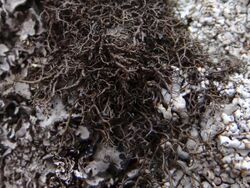Biology:Pseudephebe pubescens
| Pseudephebe pubescens | |
|---|---|

| |
| Scientific classification | |
| Domain: | Eukaryota |
| Kingdom: | Fungi |
| Division: | Ascomycota |
| Class: | Lecanoromycetes |
| Order: | Lecanorales |
| Family: | Parmeliaceae |
| Genus: | Pseudephebe |
| Species: | P. pubescens
|
| Binomial name | |
| Pseudephebe pubescens (L.) M.Choisy (1930)
| |
Pseudephebe pubescens, also known as 'fine rock wool', is a temperate alpine lichen.[1] It is a member of the genus Pseudephebe, a lichen group characterized by dense mats of brown to near-black "hairs".[1]
Taxonomy
Linnaeus first described Lichen pubescens in 1753.[1] Maurice Choisy transferred it to the genus Pseudephebe in 1930. It is usually distinguished from P. minuscula due to P. pubescens preferring a moister habitat, and its branches are more terete and lack the irregularities of P. minuscula.[2] The morphological and ecological differences between the two species are often overlapping, and it can be difficult to truly distinguish the two without molecular analysis.[3][4]
Description
Pseudephebe pubescens is a fruticose lichen that forms decumbent mats made of isotomic-dichotomous branching thalli. The branching occurs frequently and weaves around itself, leading to the woolen appearance. Dark brown to black in color and shiny.[5] Apothecia are rare, but are rarely greater than 6 mm in diameter and have the same appearance as the rest of the thallus.[6] The species lacks isidia, soredia, and pseudocyphellae.[3] Pycnidia occur in great numbers on tubercles with conspicuous ostioles. It is not known to produce any secondary metabolites.[7]
Habitat and distribution
Pseudephebe pubescens is found specifically on acidic or silicate rocks in temperate-alpine or sub-arctic regions.[1] It has circumpolar sightings, being found from the Canadian territories, throughout the United States, and sometimes in alpine Mexico.[1] It has been known in Europe, but recently discovered in China[4] and even been found in the Andes and in Australia.[8] It has been known to grow upon wood occasionally. Pseudephebe pubescens tends to be in more temperate environments than P. minuscula.
References
- ↑ Jump up to: 1.0 1.1 1.2 1.3 1.4 Goward, Trevor (1999). The lichens of British Columbia: Illustrated Keys. Victoria, B.C.: Ministry of Forests, Research Program. ISBN 0-7726-2194-2. OCLC 31651418.
- ↑ "Flora of New Zealand: Taxa". https://floraseries.landcareresearch.co.nz/pages/Taxon.aspx?id=_0cc9c801-ab53-4607-a4cc-a7f547fe3eaf&fileName=Lichen%20Ed2%20Pan-Z.xml.
- ↑ Jump up to: 3.0 3.1 Boluda, Carlos G.; Hawksworth, David L.; Divakar, Pradeep K.; Crespo, Ana; Rico, Víctor J. (2016). "Microchemical and molecular investigations reveal Pseudephebe species as cryptic with an environmentally modified morphology". The Lichenologist 48 (5): 527–543. doi:10.1017/S0024282916000426.
- ↑ Jump up to: 4.0 4.1 Wang, Li-Song; McCune, Bruce (2010). "Contributions to the lichen flora of the Hengduan Mountains, China 1. Genus Pseudephebe (lichenized Ascomycota, Parmeliaceae)". Mycotaxon 113 (1): 431–437. doi:10.5248/113.431.
- ↑ "Pseudephebe pubescens (L.) M.Choisy : LichenIreland". http://www.habitas.org.uk/lichenireland/species.asp?item=18959.
- ↑ LaGreca, Scott (2002). "Lichen Flora of the Greater Sonoran Desert Region". The Bryologist 111 (3): 519–521. doi:10.1639/0007-2745(2008)111[517:arlfic2.0.co;2].
- ↑ Martellos, P. L. Nimis, S.. "Pseudephebe pubescens (L.) M. Choisy". https://italic.units.it/italic/index.php?procedure=taxonpage&num=1905.
- ↑ "Consortium of Lichen Herbaria - Pseudephebe pubescens". https://lichenportal.org/portal/taxa/index.php?taxon=54585&clid=1036.
Wikidata ☰ Q10679313 entry
 |

